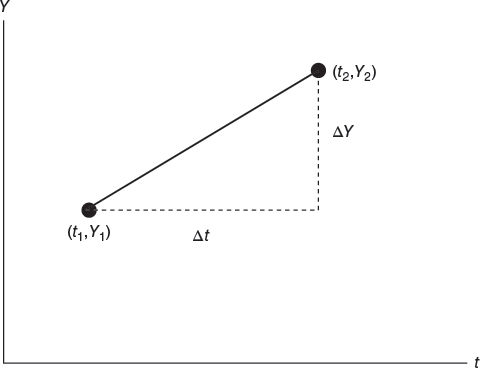4
ESTIMATION OF TREND
4.1 LINEAR TREND EQUATION
Let us consider what we shall call a purely mathematical (linear) model involving Y as a function of time t or
![]()
where β0 is the (constant) vertical intercept and β1 is the (constant) slope. Here β0 is the value of Y when t = 0 while β1 = ΔY/Δt (=rise/run). Specifically, β1 is the rate of change in Y per unit change in t. So if β1 = 5, then when t increases by one unit, Y increases by five units; and if β1 = −3, then as t increases by one unit, Y decreases by three units.
To obtain Equation 4.1, we need only two specific points in the (t, Y)-plane (Fig. 4.1). That is, β1 = ΔY/Δt = (Y2 − Y1)/(t2 − t1); and at, say, (t2,Y2), β0 = Y − β1t = Y2 − β1t2. For instance, suppose (t1, Y1) = (1, 2) and (t2, Y2) = (4, 7). What is the equation of the line passing through these two points?
Clearly β1 = ΔY/Δt = (7 − 2)/(4 − 1) = 5/3 while, at (t1, Y1), β0 = 2 − (5/3)(1) = 1/3. Hence our particularization of Equation 4.1 is Y = (1/3) + (5/3)t. So when, t = 0, Y = 1/3; and, for β1 = 5/3, when t increases by one unit, Y increases by 5/3 units.
What if we have more than two points in the (t, Y)-plane? Specifically, we may have a scatter of points such as the one depicted in Figure 4.2.

FIGURE 4.1 The line through the points (t1,Y1) and (t2,Y2).
FIGURE ...
Get Growth Curve Modeling: Theory and Applications now with the O’Reilly learning platform.
O’Reilly members experience books, live events, courses curated by job role, and more from O’Reilly and nearly 200 top publishers.

